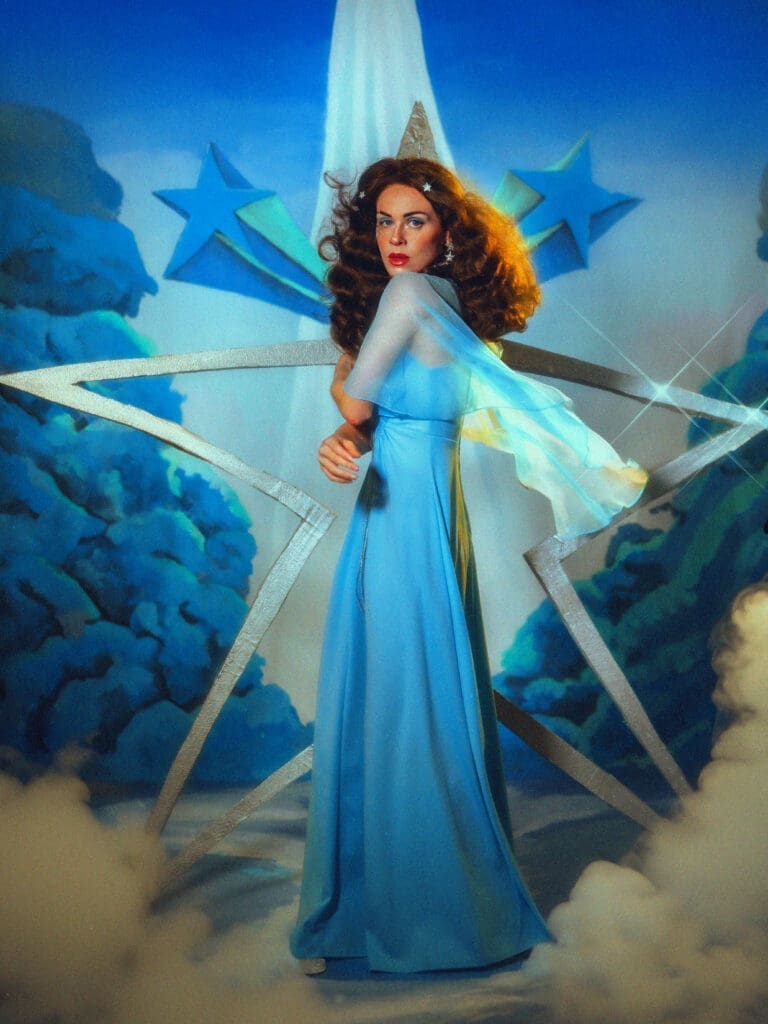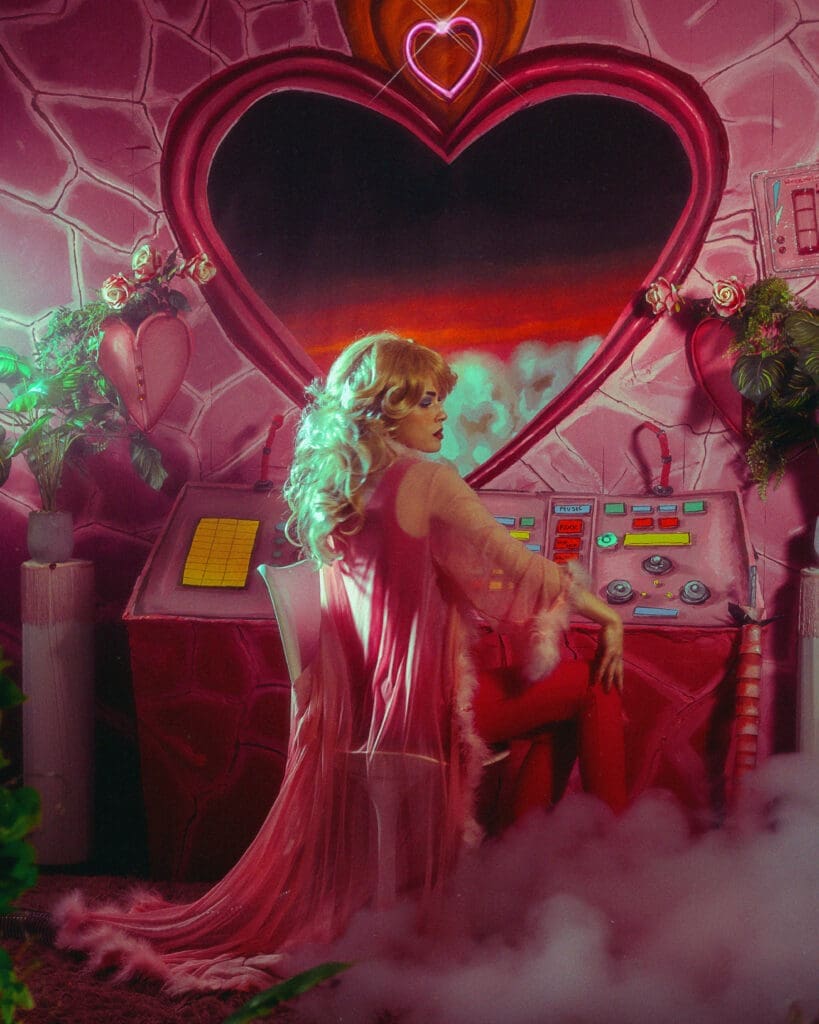TikTok time traveler and innovative content creator Maris Jones has just released her debut book, Unlock Your Aesthetic.
If you’ve ever scrolled through TikTok or Instagram, chances are you’ve paused for one of her videos. Her cinematic, DIY vignettes evoke nostalgia for past decades, but that distinct signature “aesthetic” took years to fully “unlock.”
In her new visual guide, Jones shares her process through quizzes, exercises, and personal stories, helping readers discover their own unique vibe.
We spoke with Jones about the inspiration behind her aesthetic, creating the show-stopping apple bong for Chappell Roan’s Gov Ball performance, and what she hopes readers will take away from the guide.
Who or what inspired you to write Unlock Your Aesthetic?
I was contacted by my editor at Random House, who had been following my work for a while. When I considered what I could write a book about, I immediately thought that I could explain how to help unlock the personal process of finding one’s unique visual voice. With my years of making art for a living and coming from an artistic household, I thought it would be wonderful to share the fluidity I experienced with creativity while growing up because of my circumstances!
As a child of the 90s, how fun was it to create those decision trees in the book?
I have this vivid memory of how excited I was to open various magazines as a child and do them myself. It was like receiving a special surprise in the mail, and I remember truly believing in the outcomes of those activities. It felt right to incorporate them into the book since I often discuss childhood and memories within the chapters and of course was extremely fun to make!

In the book you mention that “It would be nearly impossible to just come up with a truly unique style right away without taking inspiration from other creative voices.” Who are some of those “voices” that helped you in your journey to discover your aesthetic?
There are so many influences, but I would say the first real influence that made me want to create was when my mother showed me the original Clash of the Titans film. I was blown away by the stop-motion work of Ray Harryhausen within the film and how he brought mythical creatures and worlds to life, even though they didn’t actually exist. It unleashed my love for world-building.
More than these specific influences though, I find inspiration from little elements of people or objects. Like I might love the colors used in one scene of an old movie but love the lighting from a window I viewed in my real life, combining these pieces informs something new in my creative process.
You are behind Chappell Roan’s iconic apple bong at Gov Ball. Can you share the story behind creating that piece from concept to its stage debut?
When I was asked to create the apple bong, I was thrilled—it was such an extra and outrageous concept, which made it even more exciting! At the time, I happened to be on vacation and didn’t have any of my digital drawing tools, so I sketched it out on a napkin. I created a few variations; my initial ideas were much more elaborate, but with only two weeks to bring it to life, I had to pull back and be more practical.
When working on a project that requires a team, I collaborate with my sister, who is a fabulous producer. She really came through by finding fabricators who had access to a wood shop to shave and assemble the shell of the apple, as my studio wasn’t set up for that type of work not to mention it’s a four floor walkup. They delivered a bare shell, and I had a team of friends to help paint the weed nuggets while I fabricated and painted the other elements. It was honestly a blast. My sister and I then drove it to Gov Ball, where four of us rolled it out on stage. It was such a special moment and a fun experience, even with the tight timeline. I’m so grateful for all the people who came together to help me make it happen and help me bring her vision to life.
In working with artists like Chappell, how do you balance an artist’s aesthetic with your own aesthetic?
It truly involves trusting that, at the end of the day, when you create something for another artist, your hand in shaping the vision will remain true to how you typically approach your own work. I know I lean into my organic hand in how I create, so I make an effort to learn as much as possible about the artist and understand the references that inspire them because I know I won’t stray from my natural approach. This helps me find let go and find common ground.
That being said, it’s important to remind yourself that if an artist commissions you for work, they likely already align on certain physical traits, which creates a harmonious foundation. I also believe in putting my ego aside and genuinely trying to understand what they want, recognizing that I am there to help facilitate their vision. I treat all collaborative work as a fun opportunity to learn a new approach or do something I might not have naturally pursued on my own. Approaching these projects as if they are solely for yourself makes a world of difference.

Your decade videos are filled with so many details to transport viewers back to those time periods. What goes into researching and curating those period specific details?
I really try to lean into color and shape. Color often determines how we feel about a specific era, as each time period is characterized by certain color palettes used in various products. Over time, I have focused on learning more about art history and the design movements that emerged during different periods, which allows me to make informed decisions in my own work. However, I strive to embrace my romantic vision of that moment in time.
I am deeply driven by music and its connection to memory, so I often use a specific song as the foundation for the sets I create. Additionally, I love reading old magazines; they capture the essence of what was happening during that season, providing insights into current events and trends.
One easter egg that appears throughout many of your videos is your fictional “yolo” branding (i.e.. Yolo spray, Yolo records, Yoloroid, and Yolo jukebox). What is the story behind Yolo and including it in your content?
The Yolo branding is my commentary on capitalism, presenting it as a generic brand while emphasizing that we only live once, so we might as well buy the thing HURRY UP. I aim to infuse a sense of unseriousness into it because, over time, we tend to purchase the same products repeatedly, they just look a bit different and it’s all quite ridiculous. The cycle of it all.
In writing and designing Unlock Your Aesthetic, did you discover anything new about your own aesthetic?
What I learned from writing the book is that I had all these systems in place that I wasn’t fully aware of until I began to write them out. Once I did, I could see all the little pieces of my child self infused into this new creation that feels completely authentic to me. It’s fascinating to look at everything spread out in front of me.
What do you hope readers take away from Unlock Your Aesthetic?
With the combination of personal stories, visually captivating guides, and quirky prompts makes this book unique. It’s not just about theory but about practical application and discovering one’s true creative voice through engaging and interactive content and that you already have the answers whether you realize it or not, and don’t worry about being perfect or having the tools. Just go for it and enjoy the journey!
Get your copy of Unlock Your Aesthetic here!
To follow allow with Maris Jones’ work, visit her TikTok here and her Instagram here.